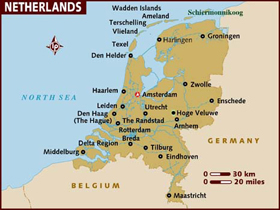Pharmacoeconomic Guidelines: The Netherlands
Country/Region: The Netherlands

PE Guidelines
Guideline for Economic Evaluations in Health Care (Dutch Version January 2024)
PE Guidelines Source:
National Health Care Institute (ZIN)
http://www.zorginstituutnederland.nl
http://www.zorginstituutnederland.nl
Additional Information:
Manual on QALY and Quality of Life Measurements
PDF in Dutch
Uncertainty and Value of Information
PDF in Dutch
Information current as of Tuesday, March 5, 2024
Key Features
| Key Features | |
|---|---|
| Type of Guidelines | PE Guidelines |
| Title and year of the document | Guideline for conducting economic evaluations in health care - 2024 version |
| Affiliation of authors | National Health Care Institute |
| Purpose of the document | Providing guidance for conduct of EE studies for reimbursement issues in order to improve their quality, credibility and comparability. |
| Standard reporting format included | Yes. |
| Disclosure | Yes. |
| Target audience of funding/ author's interests | Who conduct economic evaluations or evaluate the economic evaluations studies (ie decision makers). |
| Perspective | Societal perspective, including unrelated medical costs in life years gained. |
| Indication | Approved indication; although sometimes off-label use is considered for comparator. |
| Target population | In line with the reimbursement request. |
| Subgroup analysis | Yes. |
| Choice of comparator | Standard of care or usual care in the Netherlands, and the most cost-effective alternative if it is not standard of care or usual care. |
| Time horizon | Life time, unless there are reasons for a shorter time horizon. |
| Assumptions required | Yes. |
| Preferred analytical technique | CUA |
| Costs to be included | Costs in healthcare, costs for patients and family, costs in other sectors. Unrelated medical costs in life years gained should be included in the base case. |
| Source of costs | Reference prices list (costing manual) should be used. |
| Modeling | Yes. |
| Systematic review of evidences | Yes. |
| Preference for effectiveness over efficacy | Yes. |
| Preferred outcome measure | QALY |
| Preferred method to derive utility | EQ-5D-5L using the Dutch value set. |
| Equity issues stated | Not explicitly. |
| Discounting costs | 3% |
| Discounting outcomes | 1.5% |
| Sensitivity analysis-parameters and range | Use standard error, otherwise ±20% of the mean. |
| Sensitivity analysis-methods | Univariate, probabilistic, scenarios, and value of information (VOI), including expected value of perfect information (EVPI) and expected value of partial perfect information (EVPPI). |
| Presenting results | Must be clear. Present total costs and effects, incremental costs and effects all from the probabilistic analysis. Present results of sensitivity analysis in tables and appropriate figures. |
| Incremental analysis | Yes. |
| Total costs vs effectiveness (cost/effectiveness ratio) | Yes. |
| Portability of results (Generalizability) | Study must refer to national context; utilities preferably calculated using Dutch value sets. |
| Financial impact analysis | No, not in guideline. |
| Mandatory or recommended or voluntary | Mandatory |
Acknowledgement: